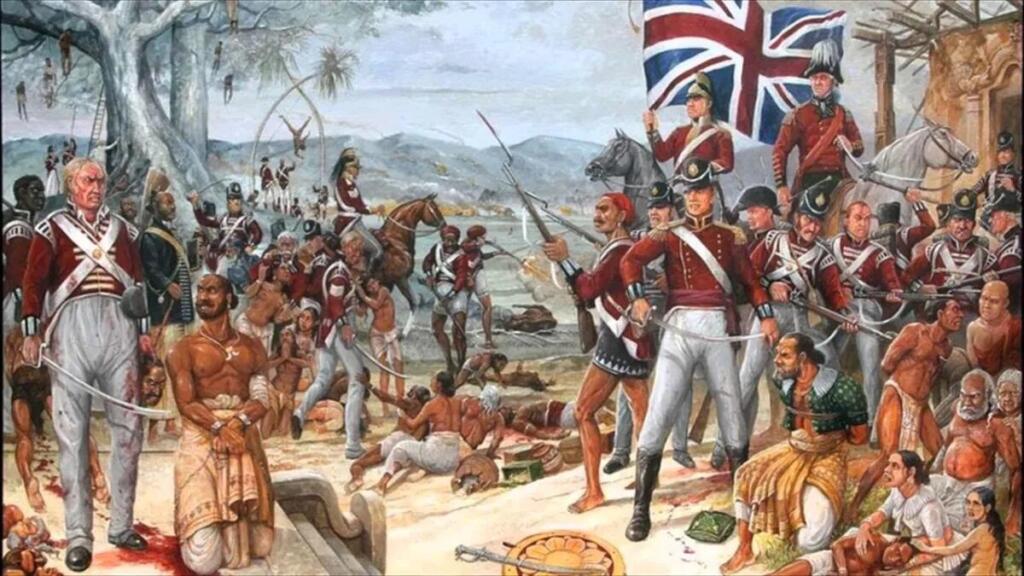Initially, the British arrived in India with purely commercial intentions. However, a series of events and decisions by the Mughal rulers gradually paved the way for British dominion over the subcontinent, lasting nearly two centuries.
The transformation of British presence in India from mere traders to colonial rulers is a tale of opportunism, diplomacy, and gradual expansion. This journey, spanning from the early 1700s to the 1850s, was marked by the decline of Mughal power and the rise of the British East India Company.
The Mughals exploited India and led an extravagant lifestyle at the cost of the country’s economic drain. As the economy declined and the Mughals weakened, they either lost control to the British or handed it over to them. During this period, Indians, mainly Hindus, were divided into clans such as Rajputs, Marathas, Sikhs etc and were never united, allowing outsiders to take advantage of this disunity.
Mughal Concessions and Support
In the early 18th century, the Mughal Empire, though still vast, was beginning to show signs of weakness. The British East India Company, initially seeking only trade privileges, found opportunities to expand their influence:
1. Trading Rights
Emperor Farrukhsiyar granted the Company a ‘firman’ (royal decree) in 1717, allowing duty-free trade in Bengal. This significant concession gave the British a substantial economic advantage.
2. Military Assistance
As the Mughal Empire faced internal rebellions and external threats, they increasingly relied on British military support. This dependence allowed the Company to gain a foothold in Indian politics.
3. Administrative Roles
The Company gradually assumed administrative roles in various regions, often at the invitation of local rulers seeking protection or support against rivals.
Mughal Inefficiency and Decline
The Mughal Empire’s decline created a power vacuum that the British were eager to fill:
1. Weak Central Authority
After Aurangzeb’s death in 1707, the empire saw a succession of weak rulers, unable to maintain control over the vast territory.
2. Provincial Autonomy
As central authority weakened, provincial governors (nawabs) and local rulers began asserting their independence, fragmenting the empire.
3. Economic Mismanagement
The Mughal court’s extravagant lifestyle and inefficient tax collection system drained the empire’s resources, weakening its ability to govern effectively.
Deception and Internal Strife
The British skillfully exploited divisions within the Mughal ranks:
1. Divide and Rule
The Company played different factions against each other, supporting one ruler against another to gain concessions and territory.
2. The Battle of Plassey (1757)
A prime example of British manipulation was the Battle of Plassey, where they supported Mir Jafar’s coup against Siraj ud-Daulah, the Nawab of Bengal. This victory gave the Company control over Bengal, a rich province of the Mughal Empire.
3. Puppet Rulers
After Plassey, the Company installed puppet rulers in Bengal and other regions, maintaining a facade of local rule while exercising real power.
Mughal Luxury and Economic Exploitation
The lavish lifestyle of the Mughal court and nobility contributed to the empire’s decline and the Company’s ascendancy:
1. Excessive Taxation
To fund their opulent lifestyle, Mughal rulers imposed heavy taxes on peasants and traders, causing widespread economic distress.
2. Neglect of Infrastructure
Resources that could have been used for public works and economic development were instead spent on palaces, jewels, and courtly pleasures.
3. Economic Vacuum
As the Mughal economy faltered, the well-organised British East India Company was poised to fill the gap, offering a semblance of stability and economic opportunity to local elites.
The Company’s Gradual Takeover
Between 1750 and 1850, the Company systematically expanded its control:
1. Subsidiary Alliances
Under Lord Wellesley, the Company formed alliances with Indian rulers, offering military protection in exchange for control over foreign affairs and stationing British troops in their territories.
2. Doctrine of Lapse
Lord Dalhousie’s policy allowed the British to annex princely states if a ruler died without a natural heir, significantly expanding Company territory.
3. Military Conquests
The Company waged wars against various Indian powers, including the Marathas, Mysore, and the Sikhs, gradually bringing most of the subcontinent under its control.
By the 1850s, the British East India Company had effectively transformed from a trading enterprise to the de facto ruler of India. This transition was facilitated by Mughal decline, internal divisions among Indian rulers, and the Company’s shrewd political and military strategies.
The Company’s rule, however, was not without challenges. Growing resentment against British policies and interference in local affairs culminated in the Indian Rebellion of 1857. This event marked the end of both Mughal rule and Company rule, leading to the establishment of direct British Crown control over India in 1858.
ALSO READ: India-Bangladesh Relations Grow Stronger with Recent Meeting
